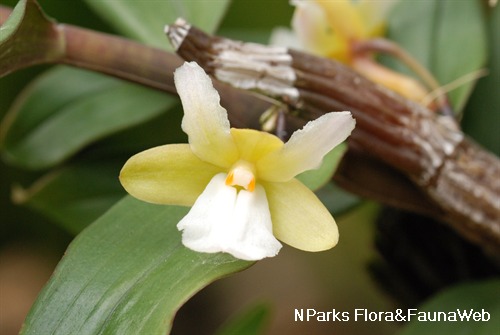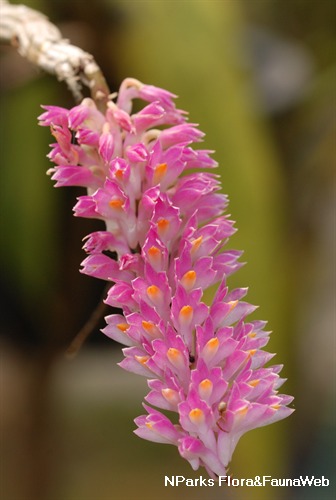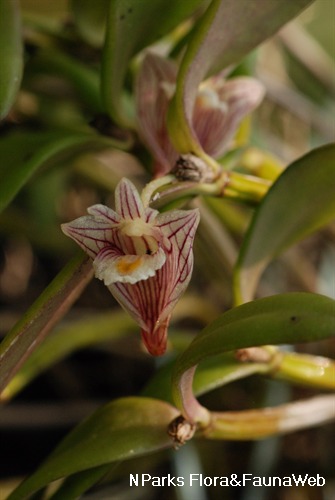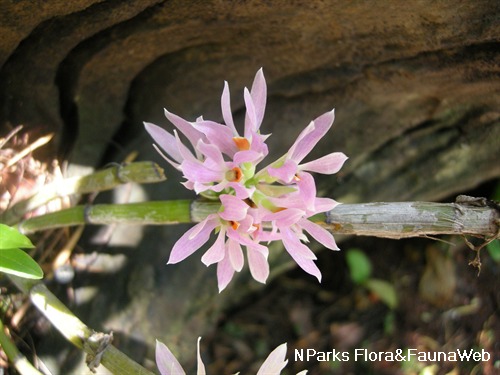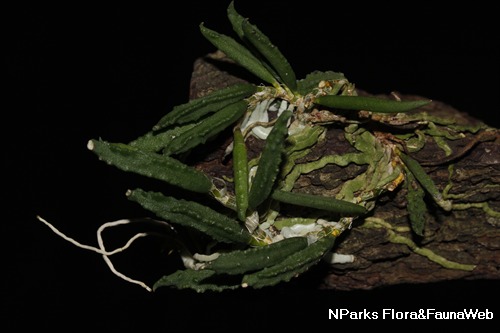
Back
Dendrobium cucumerinum McLeay ex Lindl.
| Family Name: | Orchidaceae |
| Synonyms: | Dockrillia cucumerina (McLeay ex Lindl.) Brieger |
Name
Classifications and Characteristics
| Plant Division | Angiosperms (Flowering Seed Plants) |
|---|---|
| Plant Growth Form | Epiphyte, Herbaceous Plant |
| Lifespan (in Singapore) | Perennial |
Biogeography
| Native Distribution | Queensland, Australia |
|---|---|
| Native Habitat | Terrestrial |
| Preferred Climate Zone | Tropical, Sub-Tropical / Monsoonal |
Description and Ethnobotany
| Growth Form | Miniature epiphytic orchid growing nearly adpressed to the bark of trees |
|---|---|
| Foliage | Leaves mid-dark green, 1.5-2.5cm long, almost fusiform, thick, succulent; surface rough, leathery, often with raised bumps or 'warts' forming ridges along the length of the leafrarely smooth, some leaves almost 4-angled. |
| Stems | Rhizomes are slender and creeping. |
| Flowers | Flowers foul smelling, small, non resupinate; sepals and petals very dull yellow - cream, with dark red - reddish purple lines running along the veins from the base of the sepals and petals to 1/2 of its length; lip frilly, base color of upper surface white, centre of lip cream-dull yellow with dark red- reddish purple undulate markings; undersurface of lip with dark red-reddish purple markings. |
| Habitat | Found on river oaks near to watercourses at elevations of 50 to 800 m. |
| Cultivation | The plant is best mounted on a tree fern or cork. |
| Etymology | The specific epithet 'cucumerinum' refers to the leaves, which resembles miniature gherkins or cucumbers. |
Landscaping Features
| Desirable Plant Features | Ornamental Foliage, Ornamental Form |
|---|---|
| Landscape Uses | Small Gardens, Interiorscape/ Indoor Plant, Container Planting |
Fauna, Pollination and Dispersal
| Pollination Method(s) | Biotic (Fauna) |
|---|---|
| Seed or Spore Dispersal | Abiotic |
Plant Care and Propagation
| Light Preference | Full Sun |
|---|---|
| Water Preference | Moderate Water, Little Water |
| Rootzone Tolerance | Drought Tolerant, Low Humidity / Aircon |
| Planting Remarks | Grows best under 1 layer of shade netting (70=80% sun) and on a piece of cork bark; allow the plant to dry off before resuming watering. Benefits from being grown in environments with cooler night time temperatures. |
| Fertilizing | Feed regularly with dilute liquid fertilizers meant for epiphytic orchids |
| Pest(s) | Sucking Insects |
| Propagation Method | Tissue Culture |
Foliar
| Foliage Retention | Evergreen |
|---|---|
| Mature Foliage Colour(s) | Green |
| Mature Foliage Texture(s) | Rough, Thick |
Image Repository
Others
| Master ID | 32504 |
|---|---|
| Species ID | 6916 |
| Flora Disclaimer | The information in this website has been compiled from reliable sources, such as reference works on medicinal plants. It is not a substitute for medical advice or treatment and NParks does not purport to provide any medical advice. Readers should always consult his/her physician before using or consuming a plant for medicinal purposes. |

